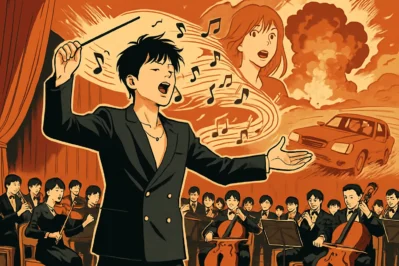K-Pop’s Secret Weapon: The Art of Orchestral Arrangement
Hello! Welcome to [Maeil Hangeul], where we upgrade your Korean skills to the next level!
Have you ever listened to a K-pop song and felt like you were watching an epic movie? That soaring, dramatic feeling often comes from a powerful secret weapon: the orchestra. Today, we’re going beyond simple lyrics and diving deep into the sophisticated world of orchestral arrangement techniques in popular music (대중음악의 오케스트라 편곡 기법).
Lately in Korea, there’s a huge trend of K-pop groups incorporating grand, cinematic orchestral sounds to build intricate storylines and “universes” for their music. Understanding the language used to describe these techniques will not only impress your Korean friends but also give you a professional-level appreciation for the music you love. Let’s tune up and get started!
Core Expressions for the K-Pop Connoisseur
Here are some key terms you’ll hear in professional music discussions in Korea.
1. 편곡 (Pyeongok)
- Pronunciation [Romanization]: Pyeon-gok
- English Meaning: Musical Arrangement
- Detailed Explanation: While this can simply mean “arrangement,” at an advanced level, 편곡 refers to the entire creative process of re-imagining a song’s composition. It involves deciding which instruments play which parts, structuring the song’s dynamic flow, and adding new melodic or harmonic layers. It’s about transforming a basic melody and chord progression into a full-fledged sonic experience. The person who does this is a 편곡가 (pyeon-gokga).
2. 기승전결 (Giseungjeongyeol)
- Pronunciation [Romanization]: Gi-seung-jeon-gyeol
- English Meaning: A classic narrative structure: Introduction (기), Development (승), Turn/Climax (전), and Conclusion (결).
- Detailed Explanation: Originally from classical Chinese poetry, this concept is fundamental to all forms of Korean storytelling, including music. A great orchestral arrangement often follows this structure. The strings might subtly introduce a theme (기), build tension through the verses (승), erupt into a dramatic climax at the bridge or final chorus (전), and then resolve beautifully in the outro (결). Using this term shows a deep understanding of structural flow.
3. 감정을 고조시키다 (Gamjeong-eul Gojosikida)
- Pronunciation [Romanization]: Gam-jeong-eul Go-jo-si-ki-da
- English Meaning: To heighten/escalate emotions; to build to a climax.
- Detailed Explanation: This is a crucial phrase for describing the function of an orchestral arrangement. It’s not just about adding pretty sounds; it’s about manipulating the listener’s feelings. You can use this to describe how a swell of violins or a powerful brass fanfare makes a song more exciting or heart-wrenching. It’s a highly expressive and descriptive phrase perfect for musical analysis.
4. 대선율 (Daeseonyul)
- Pronunciation [Romanization]: Dae-seon-yul
- English Meaning: Counter-melody
- Detailed Explanation: This is a specific music theory term. A 대선율 is a secondary melody played simultaneously with the main melody to create a richer texture. In K-pop orchestral arrangements, you might hear a cello playing a beautiful counter-melody underneath the main vocal line during a chorus, adding a layer of sophistication and emotional depth. Identifying a 대선율 demonstrates a very keen musical ear.
Example Dialogue: In the Producer’s Chair
Here’s how these terms might be used in a conversation between two music producers, Minjun (A) and Sora (B).
A: 소라 씨, 이번 아이돌 신곡 편곡 들어봤어요? 현악기 파트가 정말 예술이던데요.
A: Sora, have you heard the arrangement for the new idol track? The string parts are a work of art.
B: 그럼요. 특히 프리코러스에서 스트링 섹션이 감정을 점차적으로 고조시키는 방식이 정말 탁월했어요. 곡 전체의 기승전결 구조를 완벽하게 살려주더라고요.
B: Of course. The way the string section gradually heightens the emotion in the pre-chorus was particularly brilliant. It perfectly amplified the song’s overall narrative structure.
A: 맞아요. 그리고 마지막 코러스에 깔리는 첼로 대선율 들었어요? 그게 없었다면 이만큼 감동적이진 않았을 거예요.
A: Exactly. And did you hear that cello counter-melody underneath the final chorus? It wouldn’t have been nearly as moving without it.
B: 동감이에요. 이번 편곡은 거의 영화음악 수준이에요.
B: I agree. This arrangement is practically on the level of a film score.
Culture Tip & Trend Deep Dive
The “Cinematic Universe” Era of K-Pop
Why are these grand orchestral arrangements so popular right now? It’s deeply connected to the “universe” (세계관) trend in K-pop. Groups like ATEEZ, Stray Kids, and LOONA aren’t just releasing songs; they’re building complex narratives that span multiple albums.
The orchestral 편곡 functions as the “score” to this cinematic universe. It transforms a three-minute song into a chapter of an epic saga. The 기승전결 of the music mirrors the hero’s journey in their storyline, and the ability of the orchestra to 감정을 고조시키다 is essential for making fans feel invested in the lore. So, when you hear those epic strings, you’re not just hearing a song—you’re hearing the sound of world-building. Mentioning this connection will make you sound like a true K-pop industry insider!
Wrap-up & Practice
Today, we explored the sophisticated language used to discuss orchestral arrangements in Korean popular music. We learned how a great 편곡 (arrangement) uses a 기승전결 (narrative structure) and tools like a 대선율 (counter-melody) to 감정을 고조시키다 (heighten emotion).
Now, it’s your turn to be the critic!
- Sentence Analysis & Creation:
Think of a K-pop song you love that features a prominent orchestra. Using the terms we learned today, write one or two sentences in Korean analyzing its arrangement.
(Example: “이 곡의 편곡은 현악기의 대선율을 활용하여 곡의 기승전결 구조 내에서 감정을 효과적으로 고조시킨다.” – This song’s arrangement effectively heightens emotion within its narrative structure by utilizing a string counter-melody.)
Share your analysis in the comments below! We’d love to see which songs you choose. Happy listening






